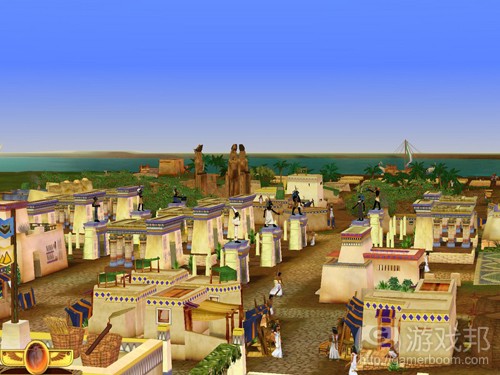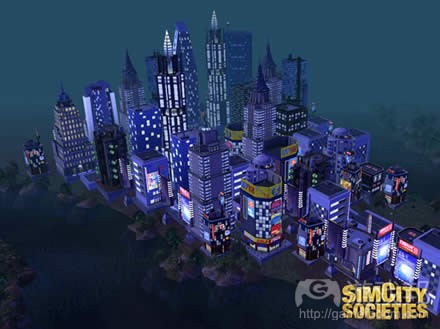回顾经典探讨城市建设题材游戏的发展历程
作者:Josh Bycer
城市建设一直是我钟爱的游戏题材之一,最近,Good Old Games商店出售的一些Impressions系列不禁引发我关于这类题材从发展到衰落的思考。回顾以往游戏,我们几乎可以描绘出该题材在不同游戏上的发展历程。
并行火车
当我思考自己为何喜欢城市建造游戏时,我想到了那些喜爱组装火车的人们。当你看到自己组装起来的物体不仅可以运行,而且可以高效行使时,一种成就感便油然而生。看着多列火车同时出发,且在你设计的轨道上平稳行驶。体验城市建造游戏的玩家同样可以体会到这种感受。
掌握诸如《模拟城市》中的城市建设技能并非易事,因为你必须处理人口增长、公共设施安置、税收、环境美化与其它事情构成的多个互联系统。建设一座大型城市,保证所有事物均在自己的掌控之中便是一种巨大成就。为此,让我们乘坐时光机,回顾那些可以完美体现这一题材的佳作。
模拟类型
很久以前,人们便知道,模拟题材是指在《模拟城市》中构建城市。于1989年发行的《模拟人生》初作奠定了城市建设题材的基础。玩家可以在游戏中选择体验随机生成的地图,或是为重大灾难后的城市重建制定方案。
这类游戏不会操控或者限制玩家的选择。玩家可以自由构建自己喜爱的城市造型。只要他们拥有足够资金,他们就可以构建自己的理想建筑。
有趣的是,由于建造城市的自由性,游戏并未预先定义构建进度,但游戏中会通过出现更新型建筑体现其发展速度。
一开始,玩家便拥有所有解锁物品,因此他们能够看出建设小型水塔与大型水质净化工厂之间的差异。但如果资金不足,玩家就无法实现这一愿景,除非他们倾其所有,花光所有的钱来建设这一设施。
这种形式极其类似现实城市发展,正如每个人都希望自己居住的城市是个乌托邦社会,但其相应建造成本则十分高昂。而能够在现实与《模拟城市》中实现这一愿景的唯一办法是,减缓完美城市的建造进度,比如节约税收支出,一次只购买一个大型服务设备。
从场景的角度看,《模拟城市》更像一款沙盒游戏,而后才称得上是真实游戏。对于想要获得更多关注或挑战模式的玩家,他们应启动另一个系列。
Impressions时代
在90年代,我们目睹大量战略或解谜元素添加到城市建造题材中。Impressions发行的城市建造游戏可谓是这类风格的典范。于1992年发行的《凯撒大帝》便注定了Impressions系列的城市构造模式与《模拟城市》存在差异。
在《模拟城市》中,你可以在现代背景下自由从事自己喜爱的项目。而在《凯撒大帝》中,你必须完成既定目标,从而获取地图。由于《凯撒大帝》设置在特定的历史背景下,因此,玩家必须建造符合这一时代特点的城市:也就是说,城市中不存在水厂或警察,而是引水槽与守卫。
同比《模拟城市》,转向任务结构模式同时赋予Impressions系列更多的解谜元素。在获取每张地图时,玩家必须在有限的空间或解锁建筑中完成任务。同比开放结局的《模拟城市》,玩家更容易掌握《凯撒大帝》的玩法,因为玩家无需在一开始面对几十座建筑的困扰。他们可以体验战役、了解游戏理念,而后在战斗后建造城市。
随着时间流逝,我们发现,许多最新发行的系列作品均遵循Impressions的挑战风格,即玩家需在不同背景下建造城市。比如《Stronghold》、《Tropico》与《Startopia》便是如此。
虽然这些游戏均采用免费模式,但其突出之处却是它为玩家提供的挑战模式。
早期城市建造游戏的其它主要部分是“步行系统”。玩家不能只是到达自己喜爱的地方,他们必须遵循你制定的路线系统。如果有人正遭受干渴折磨,除非道路旁边附有井,否则玩家无法找到水资源。而这主要源于当时的有限科技,而之后系列均打破了这种局限。
到了2001年,Impressions公司的某些元老纷纷离职,创立了Tilted Mill,人们高度期待下一代城市建造游戏的诞生。
Tilted的视角
Tilted Mill在短短十年内就打破了城市建造题材的惯用手法。其首款游戏《尼罗河之子》(游戏邦注:以下简称《CoTN》)延续了《法老王》的精髓理念,同时改变了这类题材的惯例。
首先是移除了既定路线,虽然路线有助于玩家快速移动,方便村民与理想建筑的互动。如同先前的城市建造游戏,你可以在其中选择某个战役,或是建造城市的开放地图。
我尤为偏爱《CoTN》中不同于其它城市建造游戏的构造方式。你的城市中居住着4个不同职业:农民/农奴、店员、政府人员以及上流贵族。每个职业都需要其它三种职业的支撑,以此维持自己的生活方式。
农民主要效劳于贵族,种植食物,以此获取一定报酬,剩余产品均为贵族所有(除去税收与玩家所得)。他们可以利用食物购买店员制作的产品。同时,当食物大获丰收,且政府人员为城市周围提供特殊服务时,游戏会支付他们相应的税后食物。
游戏需追踪记录大量资源,其中包括基本食物、大理石,甚至是受过教育的市民。而在《模拟城市》中,玩家无需通过战斗解锁建筑,相反,它是一种可用资源。
同时,建造一座纪念碑需要耗费大量的时间、人力与资源,而完工后,这归属于一种成就。
我认为,系统、玩家与材料的交互连接确实提升了《CoTN》的游戏难度。建造矿区殖民地并非只是单单夷平建筑。实际上,你必须建造一个矿产小镇,其中要包括基础服务,并且应在矿产资源的运送回程(运回到主要城市)上布满商店。
虽然《CoTN》尝试开拓新领地,但它仍难免遭遇游戏的通俗性与发展问题。其运作方式是,你在城镇中拥有的贵族人数代表了你所掌握的农民数。而拥有更多农民意味着可以生产更多获取主要资金来源的食物。为获得更多贵族人士,你需要提升城市声誉,这意味着玩家应保持城镇人民的快乐心情,持续建造纪念碑。
问题是,如果你因为某些问题开始失去人民,那么你很难修复这个漏洞。比如,你刚刚利用自己的资源与受过教育的市民建造了一所学校。但此时疟疾爆发,城镇人民急需一座医院,但你并未拥有充足资源与受教育者,即使是摧毁学校也无法实现。因此,他们会感到尤为愤怒,城市声誉也遭到重创。
同时,城市人民会长久记住你的失败,并将此复杂化。游戏中也包含随机事件,但其中最糟糕的莫过于因为你没有建设提升威望的建筑而让法老染病去世。虽然该游戏以战役为特色,但游戏进程主要通过玩家随着时间需要更多建筑与服务而不断发展。这意味着,如果你无法快速修复某个问题;那么不久便会引发更多问题。
由于游戏在构造建筑方面不具精确性,所以游戏并未明显说明一座建筑可以产生多少资源,或者哪些地方可称为最佳位置。你可能会因为将商店放置太远而惹恼市民,而你却只能在过后知晓自己的错误。
Tilted Mill继《CoTN》之后又推出了《Hinterland》,而这是我一直钟爱的一款带有瑕疵的佳作。Tilted Mill还发行了《SimCity Societies》,但其效果并不可观。早期评论指出,该作中存在大量漏洞,而且还涉及到侵权问题。《模拟城市》的许多粉丝也不喜爱Tilted Mill对这款游戏进程所做的修改。
在《Societies》中,玩家构造的建筑可能会造就城市的不同风格。比如,建筑视角与安全中心呈现的是Big Brother的城市风格,或者银行等建筑则是摩天大楼的外观。我发现该理念的有趣之处在于它可以推动游戏发展,但玩家不喜欢一开始便锁住大量道具的城市建设游戏。
我个人喜爱Tilted Mill的作品,而且我认为城市建造题材上的转变可谓是游戏领域的一大进步。
评价当前作品
当今的城市建造题材已大幅度减少。目前引领这一题材的主要发行商是Blue Byte,其代表作为《Anno》与《Settler》系列。
虽然我喜爱这些游戏,但我完全无法确定是否可以将其定义为城市建造游戏。它们的整体风格更像经济战略游戏,因为城市建造主要用于战斗或提供军队物资。保持角色开心也十分简单;只要保证他们的附近存有商品,他们便会感到满足。
《Anno》系列与《CoTN》这类游戏的最大不同之处是资源的处理方式。这两款游戏的特色都是向玩家提供大量有关收获、建造或处理的资源。但《CoTN》中的每项资源均用于既定目标与城市建造,而《Anno》则完全不同。玩家可以直接使用某种资源,或者用它构造更加复杂的资源。
《Anno》系列缺少旧式城市建设游戏(游戏邦注:尤其指《CoNT》)的结构感。我认为这部分源于它更多关注战役,因此它更具“游戏性”。而且,该系列并未包含诸如《模拟城市》或《CoTN》中的互连系统。
玩家无需拥有大量名流职业,便能相当容易地操控这类游戏系统,玩家无需为了保持角色开心而改变游戏中的任何事物。但这类事情主要取决我们这些城市管理者,正如Maxis已经多次修改新版《模拟城市》的预告视频,而且它的效果看起来十分出色。
无论你是把城市建设游戏当作一款缓慢运作的战略游戏、真实世界的模拟游戏,还是历史沙盒游戏,但这都不过是在其被灾难摧毁之前,从高度俯瞰自己建造的城市。(本文为游戏邦/gamerboom.com编译,拒绝任何不保留版权的转载,如需转载请联系:游戏邦)
A look At the City Builder Genre
by Josh Bycer
The City Builder genre is one of my long time favorites. Today’s post looks back at how the genre and design has grown over the years.
The city builder genre was one of my favorites growing up and the recent sale on Good Old Games of several of the Impressions series made me start to think about how the genre has grown and has become stuck in a sense. Looking back we can almost chart the development of the genre through the different games that have defined it.
The Train Parallel:
When I think about why I enjoyed city builders, I associate it with people who love building train sets. There is that sense of accomplishment of seeing something that you put together not only run, but run efficiently. Watching multiple trains go at the same time, without any crashes on the path that you designed. And that same feeling also exists with the best city builders.
Learning a city builder like SimCity is not a simple task, as you had multiple interconnected systems of population growth, public services, taxes, beautification and more to deal with.
Building a massive city that keeps everything in check is a major accomplishment. With that said let’s turn back the clock and look at some of the games that defined the genre.
Simming it Up:
Long before people knew who the Sims were they had to build them cities in SimCity. The original SimCity released in 1989 laid the groundwork for the city builder genre. Players could choose from either playing randomly generated maps or scenarios where they had to restore a city after a major disaster.
There was no hand-holding or limiting the player’s choices. The player had the freedom to build a city to their specifications. As long as they had the money, they could build whatever structure they wanted when they wanted.
Interestingly, while there was no pre-defined sense of progression due to the freedom of building a city, there was still in game progression in the form of building newer buildings.
Since the player started with everything unlocked they could see the difference between having a small water tower provide coverage, or a giant water purification plant. But without the money, they couldn’t build it without bankrupting the city.
This paralleled real life city development, as everyone wants their city to be a utopia, but the cost is just too great. The only option both in life and in SimCity was to try to make your perfect city slowly, by saving up money from taxes and buying those great services one at a time.
The problem with SimCity as a brand, was that it was more of a sandbox then an actual game, hence the reason for the scenarios. For people who wanted more of a focus or challenge it would take another series to start that.
The Impressions Age:
In the 90s we saw more strategy or even puzzle design added to the city builder genre. And the Impressions city builders are considered the highlight of this style. Starting with Caesar in 1992, the Impressions series were set up differently compared to SimCity.
Where in SimCity you were given freedom to do what you wanted in a modern era setting. With Caesar you had goals to accomplish to win each map. The focus on a historical setting also meant that players had to build their cities using the conventions of the time: meaning no water plants or police but aqueducts and guards.
The shift to the mission structure also made the Impressions series more puzzle like compared to SimCity. As each map challenged the player to accomplish the goals under the limitations of the map or unlocked structures. This also made it easier to learn these games compared to the open ended design of SimCity, as the player wouldn’t be overwhelmed with dozens of buildings from the get-go. They could play the campaign, understand the concepts then try building a city outside of the campaign.
Over the 90s, we saw many new series released that followed the Impressions style of challenging the player to build in a different setting. Such as Stronghold, Tropico, and Startopia among others.
While the option was there to have a free play mode in some of these games, the popularity came down to their campaigns that offered the player a challenge.
The other major part of early city builders was the “walker system”. Your people couldn’t just go everywhere they pleased, but had to follow the road systems that you laid out. If someone was dying of thirst, unless that well was attached to a road, it didn’t exist to them. In early games, the reason was due to the limited technology at the time while later series removed that limit.
When former Impressions employees left and started Tilted Mill in 2001, expectations were high to see what could become the next generation of city builders.
Tilted Views:
Tilted Mill did break the conventions of the genre during its brief time in the last decade. Their first title was Children of the Nile, which was in a way a spiritual sequel to Pharaoh, changed a lot of the conventions of the genre.
First was the removal of requiring roads, while roads would help people move quicker, villagers could interact with any buildings they wanted. As in previous city builders, you had the option of a campaign or open ended maps to build your cities in.
The big change that I loved about CoTN was how organic the game was compared to other city builders. You had four classes of people living in your city: the farmers or serfs, shopkeepers, government workers and the noble elites. Each group needed the support of the other three to maintain their lifestyles.
Farmers, who worked for the elite, grew food that would be split between their wages and given back to the nobles, along with being taxed and given to you. The food in turn would be used to pay for the products made by shopkeepers that everyone buys. Meanwhile government workers are paid by the food that is taxed when it is harvested and provide special services around the city.
There were a lot of resources to keep track of, from basic food, to marble and even educated citizens. As in SimCity, buildings weren’t locked behind campaigns but instead by the available materials.
Building a monument required a lot of time, people and resources and was really an achievement for getting one finished.
The interconnection of systems, people and materials really elevated CoTN in my opinion. Building a mining colony wasn’t something that was done by plopping down buildings. You had to actually build a little mining town complete with basic services and shops along with a way of moving the mined materials back to your main city to be worked on.
However, while CoTN braved new territory it also suffered from accessibility problems and growing pains within the genre. How the game worked was that the # of elite people you have in your town dictated how many farmers you could have. More farmers= more food which was a major source of currency. To get more elite people you needed to raise the prestige of your city, this meant keeping people happy and building monuments.
The problem was that if you start losing people due to problems, it was very hard to dig yourself out of a hole. For example: let’s say that you just used your materials and educated citizen to build a school to educate children. But then malaria breaks out and your people want a hospital, but you don’t have enough resources or educated citizens, even if you demolish the school. Because of that, the people are now pissed and your prestige takes a hit.
People also remembered your failures for a very long time further complicating matters. The game also had random events and there was no bigger game killer then losing your Pharaoh due to disease before you could build prestige boosting buildings. While the game featured campaigns, the in game progression worked by having the people want more buildings and services as time went on. Meaning that if you weren’t quick enough to fix one problem; more issues would spring up before too long.
Since the game was very loose in terms of placing structures, there was no information about how much a building produces or what was considered optimal placement. You could annoy people by placing a shop too far away, but wouldn’t know about it until afterwards.
After CoTN Tilted Mill went on to create Hinterland, which was one of my favorite flawed gems of all time. They also released SimCity Societies which sadly did not do so well. Early reviews found a lot of bugs in the game along with annoying copy protection. And many fans of SimCity didn’t like the change Tilted Mill did to the progression.
In Societies, the player could build structures that would tilt the city towards different philosophies. Such as building cameras and security centers for a Big Brother type city, or banks and such for high rises and corporations. I found the idea interesting as it gave the game a progression, but fans didn’t like playing a city builder with so many of the toys locked at the start.
Personally I enjoyed the titles from Tilted Mill and thought that the changes to the city builder genre were a great step forward.
Present Day’s View of the Past and Future:
Today the city builder genre has shrunk for the most part. Currently the main developer is Blue Byte with the Anno and Settler series.
While I enjoyed their games, I’m not completely sure if I would call them city builders. They feel more like economic strategy games, as the building of the city exists mainly for combat and troop supply. Keeping people happy is very binary; as long as they have products nearby they’re good.
The big difference between the Anno series and something like CoTN was how materials were handled. Both games featured a lot of materials for the player to harvest, build, or process. But where CoTN used each material for different purposes and buildings, in Anno things were different. A material would be used either directly, or as a part of making a more complicated material.
The Anno series lack the organic feel from older city builders, especially CoTN. I think part of it is due to the greater focused on combat, so it feels more “gamey” in that way. The series doesn’t have that same level of interconnection of systems as titles like SimCity or CoTN had.
It was very easy to “game” the system as outside of the greater needs of the elite class, nothing really changed in terms of keeping people happy. But things are looking up for us city managers, as preview videos of the new SimCity from Maxis have been making rounds and are looking good.
Whether you view a city builder as a slow paced strategy game, real world simulator, or a historical sandbox, there is still nothing like looking down on the city you made… before smashing a meteor into it.(source:gamasutra)











































 闽公网安备35020302001549号
闽公网安备35020302001549号